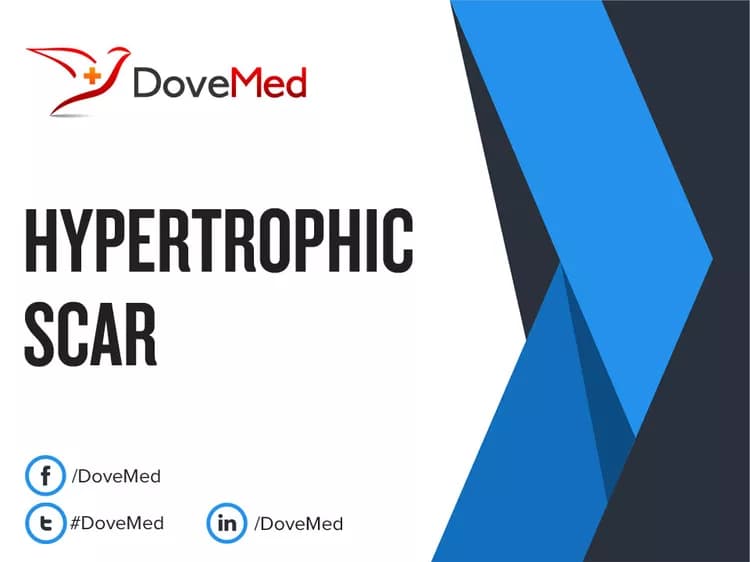What are the other Names for this Condition? (Also known as/Synonyms)
- Excessive Scar
- Hypertrophic Cicatrix
- Hypertrophic Scar of Skin
What is Hypertrophic Scar? (Definition/Background Information)
- Hypertrophic Scars are benign proliferation of scar tissue that causes abnormal scarring; they remain confined to the region of injury
- These scars may form anywhere in the body. They usually occur due to an excessive wound-healing response by the body
- Hypertrophic Scars differ from keloidal scars, where the injury results in the formation of scar tissue that is in excess of the intensity and proportion of the injury. In other words a minor injury can cause a large keloidal scar that extends beyond the injury region
- Hypertrophic Scars can cause cosmetic issues. Even though these scars may be surgically removed, they are known to recur
Who gets Hypertrophic Scar? (Age and Sex Distribution)
- Hypertrophic Scars can occur in any individual at any age
- It is observed with equal frequency in both males and females
- Individuals of all racial and ethnic background can be affected
What are the Risk Factors for Hypertrophic Scar? (Predisposing Factors)
The potential risk factors for Hypertrophic Scars include:
- Injury to the skin is the most common cause of Hypertrophic Scar. The common causes of injury include trauma, burns, and surgical incisions
- Injury to the joint areas, such as the knee and elbow joint, increases the probability of formation of these scars
It is important to note that having a risk factor does not mean that one will get the condition. A risk factor increases ones chances of getting a condition compared to an individual without the risk factors. Some risk factors are more important than others.
Also, not having a risk factor does not mean that an individual will not get the condition. It is always important to discuss the effect of risk factors with your healthcare provider.
What are the Causes of Hypertrophic Scar? (Etiology)
- The exact cause for development of Hypertrophic Scar is presently unknown
- A probable theory suggested is an abnormal response of scar-forming mechanism in the body to an injury
- The response to the injury in a Hypertrophic Scar is less than that seen in a keloidal scar
What are the Signs and Symptoms of Hypertrophic Scar?
The signs and symptoms of Hypertrophic Scars include:
- Formation of excessive scar tissue in the region of injury; nevertheless, the scar tissue is confined to the region of injury
- Normally, the scar tissue formation occurs within weeks after injury. This is in contrast to a keloidal scar, where scar tissue may form several months after an injury takes place
- Any site of the body can be affected by a Hypertrophic Scar
How is Hypertrophic Scar Diagnosed?
Hypertrophic Scars of Skin may be diagnosed as follows:
- A thorough medical history and physical examination
- Biopsy of the scarred region, if necessary: Examination of the biopsy by a pathologist under the microscope can reveal the presence of increased scar tissue
- A pathological examination helps distinguish a Hypertrophic Scar from a keloidal scar in a majority of cases
Many clinical conditions may have similar signs and symptoms. Your healthcare provider may perform additional tests to rule out other clinical conditions to arrive at a definitive diagnosis.
What are the possible Complications of Hypertrophic Scar?
The possible complications of Hypertrophic Scar include:
- The hypertrophied scar usually cause cosmetic issues
- They may be itchy and occasionally can cause an ulceration of the overlying skin. In such cases the skin may get infected, causing further complications
- Recurrence of the condition after surgical excision and removal, in some cases
How is Hypertrophic Scar Treated?
- Injection of the scar with corticosteroids is the preferred treatment for Hypertrophic Scar.
- Use of topical silicone liquids or gels can be effective
- Surgical removal of the scar tissue is a treatment option that may be recommended in some cases. However, it is important to note that in some individuals, the scar tissue may recur
- Laser therapy techniques are available, which may decrease the incidence of scar tissue recurrence after removal
How can Hypertrophic Scar be Prevented?
- It is difficult to prevent the formation of a Hypertrophic Scar
- Prompt treatment may help in decreasing the amount of scar formation
What is the Prognosis of Hypertrophic Scar? (Outcomes/Resolutions)
- The prognosis of Hypertrophic Scar is generally excellent
- The recurrence rate of such scars after removal are only about 10%, in contrast to keloidal scars, where the recurrence rate can be over 75%
Additional and Relevant Useful Information for Hypertrophic Scar:
Hypertrophic Scars should be distinguished from keloidal scars:
- In Hypertrophic Scars, the scar tissue is excessive, but is confined to the region of injury
- In keloidal scars, the scar tissue is formed beyond the region of injury
Related Articles
Test Your Knowledge
Asked by users
Related Centers
Related Specialties
Related Physicians
Related Procedures
Related Resources
Join DoveHubs
and connect with fellow professionals



0 Comments
Please log in to post a comment.